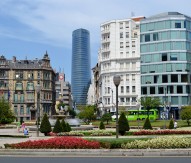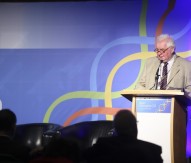

© Marc O'Sullivan Photography
The knowledge-innovation triangle
15 September 2008 saw both the largest bankruptcy filing in US history but also the window of opportunity to realise new innovation potential in Europe.
The collapse of Lehman Brothers led to a large fall in the value of shares and shook global business confidence. Yet at a first meeting of the European Institute of Innovation and Technology’s Governing Board in Budapest, Hungary, and attended by European Commission President José Manuel Barroso, plans to bring together Europe’s leading innovators, students and researchers were about to be realised.
The European Institute of Innovation and Technology (EIT) ‘aims to enhance Europe’s ability to innovate’ and ‘be one step ahead in providing solutions to rapidly emerging societal problems and developing products that meet the demands and desires of consumers’, according to its website. Since its inception five years ago, the EIT has overseen the development of three knowledge and innovation communities (KICs), targeting climate mitigation, renewable energy and ICT. The EIT receives a large proportion of its funding through the European Commission.
Speaking to delegates at Dublin Castle during the ‘Open Innovation 2.0’ conference in Ireland, Alexander von Gabain, the chair of the EIT, outlined how Europe’s innovation ingredients need to become interconnected in order to compete on the world stage.
“When we talk about innovation, I think people often mix up discovery, invention and translation. Europe has a powerhouse of first class research institutes, wonderful universities and fantastic companies – both big corporations and SMEs. Europe is also now beginning to have cross-border collaboration, yet we are still limping behind and not achieving the level of innovation that we would like to on the continent.”
Von Gabain cited the comparison of the European and American biotech industries, where around a third of US biotech operators are listed as public companies whilst less than 10% of the European biotech companies are listed on stock markets. He added that the accumulated and accrued value of the European biotech industry is “not even a third of those in the United States”. In order to tackle this problem, the chair said it was the mission of the EIT to connect research, education and industry.
“The EIT supports ideas from the lab to the market, from the student to the entrepreneur and remove the ‘silo mentality’ by creating ecosystems. We are bringing the key players together in KICs, though I prefer to use the word ‘innovation factory’. The KIC is a group of people run by a CEO following a business plan in which we invest our money and focus on driving open innovation around a certain topic, e.g. renewable energy. In the long-term, the KICs should become more autonomous and sustainable and depend on less money from taxpayers.
“If you look at the European landscape, you can see many of the important ingredients that you need for innovation – research, universities, education institutes, business schools and venture capital. We need to encourage the people, not only at universities, to take fresh ideas, develop them and become entrepreneurs. We need to drive open innovation by interconnecting the key players of the innovation and knowledge triangle. It is at the centre of this knowledge triangle that you have to place the entrepreneur. It is only by initiative you get innovation. These ingredients also have to be placed in co-location centres, encouraging interconnectivity.”
Since the development of the first KIC in 2009, over 300 partners have become interconnected in Europe and more than 108 start-up companies have also grown out of the ecosystems. Under current Horizon 2020 budget proposals, the EIT will see a significant increase in funding and the development of several new KICs, notably in the areas of food sustainability, healthy living and raw materials.
Von Gabain continued by outlining the EIT’s achievements and its development over the next seven years.
“If I’m being self-critical,” he said, “I think we have proved our existence and the KICs are already showing their first potential results. We are looking forward to receiving more money to foster the build-up of another six KICs during the next six years within the framework of Horizon 2020. We are clearly focused on societal challenges and it is clear, since we are funded by taxpayers’ money, that the KICs we implement are in line with some of the challenges facing Europe.
“We would also like these KICs to become interconnected globally because innovation itself is global. I don’t think a KIC can function alone if they do not have the contacts and counterparts in the United States, China and other emerging economies. Encouraging the KICs to become sustainable is also important.”
“We only have one blue planet to live on,” von Gabain concluded. “We need the KICs to unlock potential, facilitate competitiveness, encourage high-quality jobs and tackle the societal challenges, encouraging sustainability and making an impact on society.”
Alexander von Gabain





